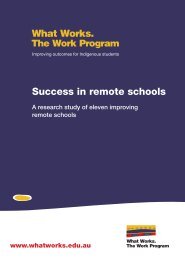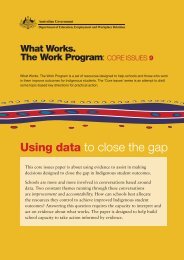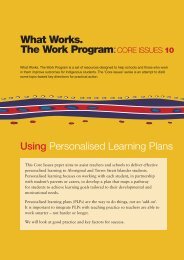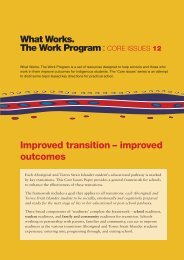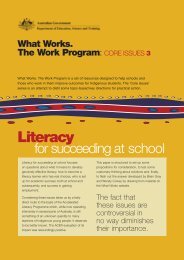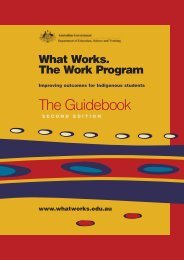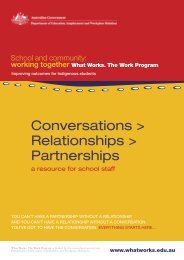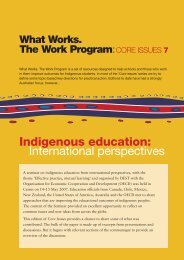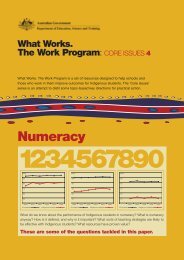STUDIES OF SOCIETY AND ENVIRONMENTPlace <strong>and</strong> SpaceConcept In Year 1the student:In Year 2the student:In Year 3the student:In Year 4the student:In Year 5the student:In Year 6the student:In Year 7the student:In Year 8the student:In Year 9the student:Significance ofplace <strong>and</strong>stewardshipPeople have arelationship with theenvironment <strong>and</strong>this can beenhanced by acommitment tosustainability.• Knows that to care <strong>for</strong>living things means tolook after them.• Identifies ways to care <strong>for</strong>living things (wateringplants, protecting koalasfrom being hit by cars).• Knows that some placesare important to people <strong>for</strong>different reasons (e.g.meeting places <strong>for</strong> people,places honouring the dead,places where peoplecelebrate importantevents).• Shows care <strong>for</strong> their ownclassroom <strong>and</strong> property(keeps their desk <strong>and</strong>space free of litter <strong>and</strong> tidy<strong>and</strong> helps clean up <strong>and</strong>after an activity).• Describes their journey toa significant place (e.g.their home) by talkingabout the features theypass on the way.• Recognises the features ofa place that make itsignificant (e.g. thefeelings that a placeevokes: wonder –bushl<strong>and</strong> or mountains;gratitude - war memorial;sadness - grave)• Know that many placesare associated withparticular activities (e.g.sporting fields, churches,mosques, temples, operahouse).• Examines why people care<strong>for</strong> their local environment(says “we look after thetrees because we needwater <strong>and</strong> food <strong>and</strong> itneeds to be healthy like weare”). Sc• Identifies a place in needof care <strong>and</strong> plans positivelocal environmental orcivic action to restore thearea (e.g. sees that thebeach has lots of litter <strong>and</strong>rubbish <strong>and</strong> plans withclassmates to clean it uponce a week to keep ithealthy). Sc• Underst<strong>and</strong>s that people ina community cancooperate to care <strong>for</strong>places (e.g. works withothers to save water <strong>and</strong>recycle rubbish). Sc• Identifies people in thecommunity who take careof places (e.g. sanitationworkers, park rangers).• Identifies examples ofAboriginal <strong>and</strong> TorresStrait Isl<strong>and</strong>er influenceson the valuing <strong>and</strong> namingof places in Australia <strong>and</strong>the local community(Uluru, Gympie,Doomadgee, Yarrabah,Bamaga).• Identifies issues aboutcare of places in theschool <strong>and</strong> community.• Knows some places wherefew people are allowed tovisit in order to preservethe place or where wehave to pay money to visitin order to pay <strong>for</strong> upkeepof the environments (e.g.national parks).• Knows that not everyoneagrees on what places tocare <strong>for</strong> (e.g. proposeddam or road sites).• Knows the meaning of theterms conservation,protection <strong>and</strong> preventionrelates them to real lifeexamples.• Identifies examples ofwhere the use of a placechanges (e.g. an old PostOffice or school, or amine site) <strong>and</strong> the conflictthat may result whenpeople disagree aboutdemolition <strong>and</strong>development versuspreservation (e.g. FranklinRiver development).• Recognises that conflictover l<strong>and</strong> usage may arisedue to cost, age, culturalbackground.• Describes the positionspeople hold on an issuerelated to the impact ofpeople’s actions on plants<strong>and</strong> animals in a place(e.g. describes theviewpoints that peoplepresent concerning theintroduction of the canetoad in Queensl<strong>and</strong> <strong>and</strong>proposed measures ofcontrol). Sc• Investigates <strong>and</strong> reports onthe management of naturalenvironments inQueensl<strong>and</strong>.• States their own views onissues relating to caring<strong>for</strong> places <strong>and</strong> justifiesthese.• Describes how beliefs <strong>and</strong>practices influence wherethey settle, how they farmor use the l<strong>and</strong> in otherways <strong>and</strong> the style ofsettlements that theycreate.• Identifies the humanimpacts on ecosystems. Sc• Identifies the impact ofhumans on naturalecosystems in Australia.• Knows that differentvalues affect ways thatpeople act to sustain theenvironment (e.g.identifies the values thatunderpin an issue ofenvironmental usage suchas making money ormaintaining wildernesswhen mining is proposedin a natural <strong>for</strong>est, orwhen the wood-chippingindustry might be closedto present trees affectingpeoples jobs). Sc• Identifies impacts onglobal ecosystems.Spatial Patterns• Knows that theenvironment is made updifferent types of places<strong>and</strong> can draw picturesrepresenting them. A• Identifies places in thelocal environment that arespecial to the community(e.g. waterways, meetingplaces, town hall , warmemorial).• Distinguishes natural,social <strong>and</strong> built places -areas distinguished bynatural features like<strong>for</strong>ests, mountains <strong>and</strong>rivers; areas altered byhumankind such as towns,farms <strong>and</strong> highways;places of importance toIndigenous groups such asUluru, meeting places <strong>and</strong>homel<strong>and</strong>s; social placessuch as where kids ridetheir skateboards, play ormeet with friends). Sc• Identifies natural, social<strong>and</strong> built places on simplemaps (mountains, rivers,coastlines, cities). N• Knows that places areused <strong>for</strong> different purposes<strong>and</strong> describes some ofthese (e.g. park is used <strong>for</strong>recreation, tip is used todump rubbish).• Describes how thedifferent rooms in thehome or the school areused.• Underst<strong>and</strong>s that peoplemake choices about howto use places.• Knows that someenvironments are hard touse <strong>for</strong> some people (e.g.beaches, mountains, <strong>and</strong>some buildings may bedifficult to access <strong>for</strong>people in a wheelchair).Sc• Suggests reasons whysome people choose tolive <strong>and</strong> work where theydo (e.g. access to schools,hospitals, the arts, family).• Locates major waterways,other natural features <strong>and</strong>population centres on amap of Queensl<strong>and</strong>. N• Knows that natural <strong>and</strong>built features can meanthat people use places indifferent ways (e.g.climate, soil <strong>and</strong> marketsaffect farming patterns,mineral deposits <strong>and</strong>transport affect miningdevelopment).• Locates major populationcentres <strong>and</strong> naturalfeatures <strong>and</strong> waterways ona map of Australia. N• Examines <strong>and</strong> describeshow advancements intechnologies haveinfluenced how places areused <strong>and</strong> give examplesfrom Australia <strong>and</strong> theancient world (e.g.irrigations, mining).• Locates places on theglobe with similarclimates, l<strong>and</strong><strong>for</strong>ms orvegetation.• Locates major populationcentres, waterways <strong>and</strong>natural features on allcontinents. N• Describes how differencesin world-view can resultin different l<strong>and</strong> use (e.g.broad-acre farming <strong>for</strong>cash crops in westernnations verses intensivefarming, <strong>for</strong> localconsumption, in manyAfrican <strong>and</strong> Asian nations.• Describes the changingpatterns of l<strong>and</strong>use(agricultural <strong>and</strong> urban)over time in Australia.• Knows that spatialpatterns result from theinterrelationships betweenvarious processes (e.g.laws <strong>and</strong> technologymight result in roadpatterns, soil <strong>and</strong> climatemight affect farmingpatterns by these are notalways similar becausethey’re also affected byproximity to markets).• Examines <strong>and</strong> describesthe range of data used bygeographers (maps, tables,statistical) <strong>and</strong> identifieswhat it tell us about theimpact of change on theenvironment. N, Sc• Represents in<strong>for</strong>mationabout places in drawings<strong>and</strong> simple maps. N• Represents environmentsusing different <strong>for</strong>matssuch as simple maps <strong>and</strong>diagrams. N• Uses a grid references tolocate places on maps(e.g. B13). N• Identifies some of thesymbols used onAboriginal maps (e.g. dot<strong>and</strong> circle drawings). A• Identifies latitude,longitude, direction <strong>and</strong>scale on a map. N• Uses latitude, longitude,direction <strong>and</strong> scale on amap to identify <strong>and</strong> locatefeatures. N• Identifies spatial patterns(including irrigation,mining, farming) frommaps using the given key.N• Uses latitude <strong>and</strong>longitude to locate placesin an atlas. N<strong>Bound</strong> <strong>for</strong> <strong>Success</strong> <strong>Scope</strong> <strong>and</strong> <strong>Sequence</strong> <strong>Statements</strong> V2 Page 69 Working Document Semester One 2007
STUDIES OF SOCIETY AND ENVIRONMENTCulture <strong>and</strong> IdentityConcept In Year 1the student:In Year 2the student:In Year 3the student:In Year 4the student:In Year 5the student:In Year 6the student:In Year 7the student:In Year 8the student:In Year 9the student:Cultural DiversityRecognising <strong>and</strong>respecting differentcultures within ourcommunity.• Knows that people fromsome cultural groups maylook or dress differentlyfrom them.• Knows that people aredifferent <strong>and</strong> can sortpeople into groups (e.g.boy/girl, young/old, skincolour, left/right h<strong>and</strong>ed).• Describes how peoplemeet their physical needsin different ways (e.g. says“we all eat different typesof food <strong>and</strong> wear differenttypes of clothes”).• Identifies how social <strong>and</strong>emotional needs are met indifferent ways (e.g. says“we go to church everySunday” or “we listen toDreaming stories when weget together as a bigfamily”).• Gives examples of diverseways in which particularoccasions are celebratedby groups in theircommunity (e.g.Christmas, Chinese NewYear, ANZAC Day) <strong>and</strong>knows that groups thatcelebrate the sameoccasion do not alwayscelebrate in the same way.• Knows that Australia is apluralist society withcitizens of diverse origins<strong>and</strong> cultural backgrounds.• Knows that the culture ofpeople changes over time.• Knows that ‘being anAustralian’ can me<strong>and</strong>ifferent things todifferent people <strong>and</strong>groups.• Knows some of thecharacteristics of theiconic Australianindividual.• Identifies a number ofdiverse groups, includingimmigrants <strong>and</strong>Indigenous, <strong>and</strong> reportson their development,impact <strong>and</strong> contributionsto national identity overtime.• Describes the culturalconnections (ie religious,spiritual, social values <strong>and</strong>beliefs) of Australianpeople/groups topeople/groups in the Asia-Pacific region.• Knows that culturalgroups share the samevalues, needs <strong>and</strong>expectations <strong>and</strong> that theseare often reflected in theirsocial organisation.• Knows that the values,needs <strong>and</strong> expectationsshared by groups canchange over time <strong>and</strong> indifferent contexts.• Knows that culturalgroups share the samevalues, needs <strong>and</strong>expectations but that thedegree to which they sharethem might be different(e.g. not all Muslimwomen wear a scarf, notall conservationists areinvolved in SeagrassWatch).• Explains values reflectedin national celebrations<strong>and</strong> what these represent(now <strong>and</strong> in the past) todiverse people <strong>and</strong> groups,including RemembranceDay, Australia Day,NAIDOC week, ChineseNew Year, Labour Day.• Examine <strong>and</strong> describes thebelief systems of differentcultural groups inAustralia.• Describes the respectiveroles of men <strong>and</strong> womenin particular culturestoday, <strong>and</strong> in othercultures over time.• Knows that nationalAustralian identity canhave different meanings<strong>for</strong> different individuals<strong>and</strong> groups.• Constructs a timeline todocument key events inthe development ofmulticulturalism <strong>and</strong>immigration policies inAustralia.• Underst<strong>and</strong>s that somecultural groups maychange their beliefsystems <strong>and</strong> socialorganisation over time inorder to survive.• Describes how Australia’scultural diversity has beenshaped by governmentpolicies onmulticulturalism,immigration, publicopinion <strong>and</strong> globalisation.Culturalexpressions <strong>and</strong>practicesAll cultural groupsare characterised byvarying degrees ofcohesion <strong>and</strong>diversity.• Listens to stories fromdifferent cultures <strong>and</strong>identifies similarities <strong>and</strong>differences in thesestories.• Participates in events fromdifferent cultures such asChinese New Yearcelebrations <strong>and</strong> an end ofRamadan meal.• Knows that some groupscelebrate differentreligious, cultural orhistorical events (e.g.Christians celebrateChristmas <strong>and</strong> Easter,Muslims celebrateRamadan).• Knows that there aredifferent cultures <strong>and</strong><strong>for</strong>ms of culturalexpression <strong>and</strong> that thesecultures have differentways of singing, dancing,painting <strong>and</strong> children’sgames.• Identifies some rituals <strong>and</strong>symbols with particularcultural groups (e.g.knows that Australianscelebrate Anzac Day toremember the soldiers whodied in wars).• Knows <strong>and</strong> usessalutations in languages ofother groups.• Knows that symbols,rituals <strong>and</strong> places reflectidentities of differentcultural groups (e.g. theAustralian flag symbolisesthe Australian nation <strong>and</strong>that Uluru is special to allAustralians).• Identifies different <strong>for</strong>msof cultural expression (e.g.some Aboriginal peoplemay use dance <strong>and</strong> musicto tell a stories as well aswritten <strong>for</strong>ms).• Describes customs <strong>and</strong>traditions of their ownfamily.• Knows that a tradition is atale or a belief or a custom<strong>and</strong> can describe some oftheir family traditions, e.g.how they celebrate NewYear.• Knows that there is arange of diversity withinAustralian Aboriginal <strong>and</strong>Torres Strait Isl<strong>and</strong>ercultures <strong>and</strong> cultures ofother groups withinAustralia.• Knows that culturalgroups have traditional<strong>and</strong> non-traditionalaspects (e.g. knows that agroup of Aboriginalpeople might have atraditional language thatis still used at home butthat they listen to radiobroadcasts in St<strong>and</strong>ardAustralian English, <strong>and</strong>that Chinese people mightgive each other gifts atChinese New Year as wellas at Christmas.• Knows that AustralianAboriginal <strong>and</strong> TorresStrait Isl<strong>and</strong>er identitiesgive central place to‘country’ <strong>and</strong> investigateswhat this means.• Lists <strong>and</strong> describes valuescontributing to peace <strong>and</strong>equity in Australiancommunities.• Recognises theinterdependence ofcultural groups <strong>and</strong> theirworld.• Underst<strong>and</strong>s that beliefs<strong>and</strong> traditions influencethe nature of cultures (e.g.the impact of theenvironment on manyAboriginal lifestyles, <strong>and</strong>attitudes towards the oldpeople in Chinesecultures).• Identifies national <strong>and</strong>global events that haveinfluenced culturalperceptions of a group ofpeople, analysing the roleof government action <strong>and</strong>policy, individuals <strong>and</strong> themedia in influencing thesein positive <strong>and</strong> negativeways (e.g. September 11,drug trafficking, famine inAfrica).• Investigates <strong>and</strong> reports onthe role of communityperception <strong>and</strong> responsesto the AustralianAboriginal <strong>and</strong> TorresStrait Isl<strong>and</strong>er people inAustralia, with particularemphasis on racism <strong>and</strong>discrimination.• Knows howimprovements indemocratic participation<strong>and</strong> citizenship rightsimpact on racism <strong>and</strong>discrimination on groups<strong>and</strong> cultures in Australia,<strong>and</strong> knows the influencesthat shape this change.• Knows that culturalbeliefs <strong>and</strong> traditions canchange over time (e.g.describes the customs,dominant beliefs, religiousinstitutions, values <strong>and</strong>education system of anancient civilisation such asEgypt, <strong>and</strong> of a presentdaycivilisation such asAustralia or New Guinea;knows that this too ischanging).<strong>Bound</strong> <strong>for</strong> <strong>Success</strong> <strong>Scope</strong> <strong>and</strong> <strong>Sequence</strong> <strong>Statements</strong> V2 Page 70 Working Document Semester One 2007



